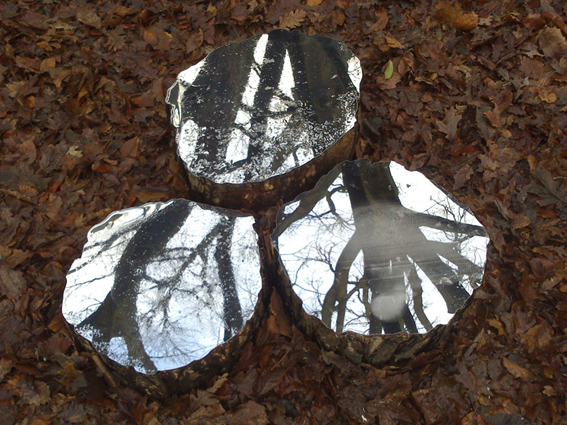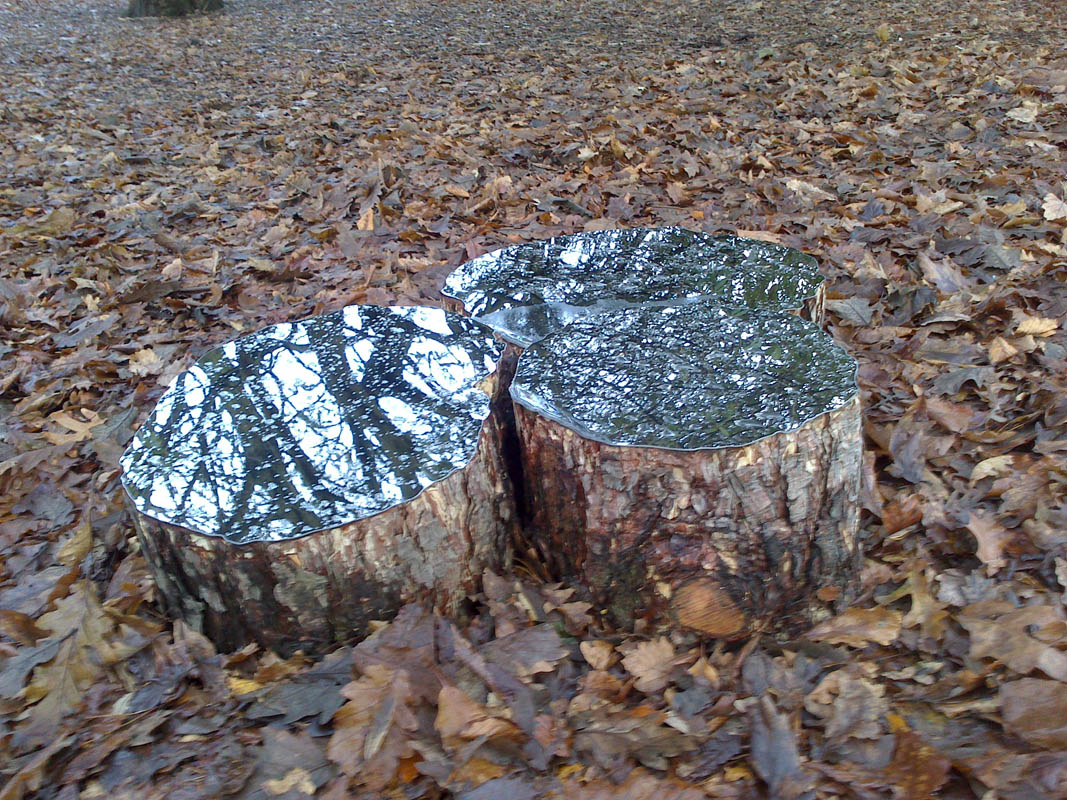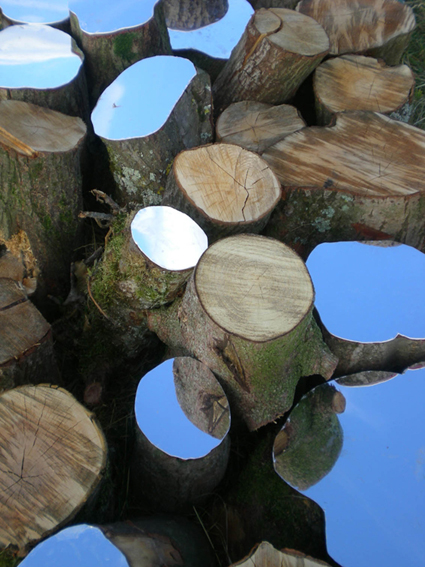mdby……LEE BORTHWICK #1







Today, Lee Borthwick, she is an installation artist and maker based in East London, she does a great job in wood and mirrors, and she speaks about her work and how she begun.
How do you define your work?
A carefully controlled version of wilderness.
How did you begin?
After completing my MA I took a studio and the first thing I made was my first mirror tapestry. An organisation called the BEDG and the UKTI supported me in exhibiting at IMM Cologne FF where I displayed my Tapestry. A few months later I received my first private commission, three interior installations for a clients house In Cyprus. Around the same time I was kindly invited to produce an organic wall covering for Grizedale Arts. Suddenly I had two exciting and diverse interior installations in my portfolio which gave the confidence to start getting my name out there.
It was very difficult starting out, I had only a few hand tools and a desk and naturally was nervous about what the future held for me but being resourceful and holding onto my long term ambition kept me hanging in there.
Does wood have a special meaning to you?
I trained as a textile designer so I am very much a material led artist, creating tactility and sensory experiences in my work is fundamental. Wood in all its forms fulfils the experience I look to achieve in my work. I see it as an evolving textile, it carries a warmth, a comforting weight, it is natural and enduring. It also has nostalgic properties, memories of landscapes visited, woodlands walked and tree’s climbed.
Wood has allowed me to work in a variety of contexts, I have always loved the notion of “bringing the outside inside and taking the inside outside” and it is a material that allows me to experiment with different environments and how they should make you feel.
Do you fabricate your designs by your own?
Yes, whilst I do draw out ideas, the ideas come initially from the materials themselves and what they want to do. I draw in a 3d fashion, constructing materials into patterns and documenting them. I only sketch out the final piece. I find it easier to build the piece and discover problems and solutions along the way rather than over design.
Have you ever been discouraged?
I have never considered walking away, I love it too much. Naturally there are many challenges- financing making new work and maintaining a studio is extremely difficult at times. In the early stages of running a business you can’t pay yourself as you reinvest everything back into growing the business. It can be hard work keeping your motivation strong but actually when you move in artistic circles you can seek inspiration from the people around you.
Which would be your ideal project?
Dream job, perhaps a commission to create some beautiful mirror installation for a log cabin by a Lake in Canada using locally sourced timber….but until that happens I generally take a lot of pleasure in working on private interior commissions with a client. I love the one-to-one relationship, it can be very collaborative, my skills get utilised and the client gets something incredibly personal and appropriate for their space.
I would also love to collaborate more with architects and landscape architects and work on more challenging projects in unusual spaces, both inside and outside, to see ideas I can’t achieve on my own come to life through a team.
How your ideas come up? Which ones are your sources of inspiration? Are you influence by anyone?
My ideas come through material exploration, I build repetitive structures and patterns with a range organic and natural materials and experiment with scales. The idea of the mirror on wood started with me taking different types of rubber into the forest and placing it on wood, the shine on the rubber made me decide I wanted to try something reflective and I started experimenting with mirror.
A period of living in Finland in 2005 and several more visits there has left a lasting impression on my work. The memories of the landscape, people, nature, space and architecture continually weave into my installations and work- I try to recapture the feel of the place. I still work with those memories now. Travel can have an incredible impact on your practice.
I am influenced many people, from artists to musicians and writers. I have drawn great inspiration over the years from artists like Andy Goldsworthy, Chris Drury, Dalziel and Scullion and Christo- great land artists who understand the appropriateness of materials and the significance materials can have once placed in a landscape. Ian Hamilton Finlay’s amazing garden “little Sparta” astounded me when I visited in 2008. I also love the writing of Lucy Lippard and her books such as “Lure of the Local”.
Which ones have been the best and the worst moments of your professional life?
To be invited to work with Grizedale Arts in the Lake District back in 2009 was certainly a highlight. Staying at Lawson Park Farm was incredibly special and I was introduced to some amazing artists who had really established careers, I was just starting out and felt very nervous and self-conscious yet delighted to be involved with the making of such a creative environment.
The worst moment was probably having my fingers trapped in the back of a chop saw for one hour in my first studio. Thankfully the injuries were minor and I wasn’t alone when the accident happened. The incident really demonstrates the fragility of using your hands to earn a living and what can go wrong when you work alone. All the “what ifs” come to mind….
Have you ever had a mentor that has supported and guided you?
I still retain a good relationship with both my BA tutor Charlie Hackett from Grays School of Art and Freddie Robins from the Royal College of Art, and from time to time to turn them for advice.
This year the Crafts Council UK have been an invaluable support to my practice. I have been participating on the Injection Scheme, which supports established and mid career designers and I have had some incredible mentoring and business support. It has led me to new networks of peers with whom I also seek advice and share experiences with.
It took me a long time to ask for help and I wish I had asked sooner.
Which is the best advice that you have received? And what is the advice that you will give.
Best advice I ever received, I was told once to just keep hanging in there until everyone else drops off.
Advice I would give, be reliable. Working hard at whatever task you are thrown will always be noted and should see you through to better things and of course saying yes to everything – you don’t know where it might lead!
What is beauty for you?
Anything that can cause a positive emotional reaction, often It is usually the most simplest idea, sound, taste or smell.
Tell us a how a normal day in your work is?
My days consist of a lot of different activities, it is a balancing act between making the work, the administration, researching and making plans for the following days, months and years. Not forgetting actually trying to sell the work. Essentially there is never enough time. Time management is a skill and takes time to learn how to plan your work and form a suitable working pattern.
Which is the most difficult from your work?
The most challenging part of my work is figuring out the physical installation of a piece and ensuring that the installation does justice to the artwork. Often when it comes to installation I have to seek advice from a variety of people from other sculptures to builders, wood workers or fabricators. I have a tendency to make the artwork first and only once it is made do I then consider how it will be installed thus creating new challenges. What fixtures to use? How will we move it? Can the walls or ceiling take the weight? will the weather damage the work? How long will it last?…
Which is what you like more from your work?
Seeing the pleasure other people take from the work. It makes the hard work and emotional investment completely worthwhile. I love seeing people interact with my work whether it is the mirrored log outside or it is a cake being served on one of my sculptural food boards.